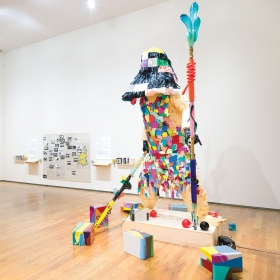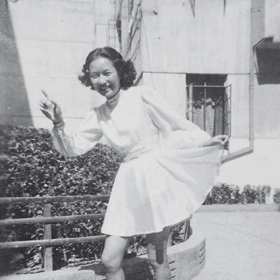When Associate Professor of Art David Teng-Olsen was spending two years creating Survival Robot (2020), a piece of art designed to withstand disaster, little did he know how soon it would be put to the test by a global pandemic.

David Teng-Olsen, Survival Robot (2020), wood, glass, steel, enamel, PLA, and six ASIC cryptocurrency miners, dimensions variable.
Photo by David Teng-Olsen
When Associate Professor of Art David Teng-Olsen was spending two years creating Survival Robot (2020), a piece of art designed to withstand disaster, little did he know how soon it would be put to the test by a global pandemic.
“I attempted to make a sculpture to solve an impossible problem, an artwork that could secure the future of its owner, in this case, my own children, family, and friends. Because countries, governments, and societies tend to rise and fall, I built a survival robot that could outlast a serious disaster,” Teng-Olsen says.
Inside the sculpture are six cryptocurrency mining machines, which each process data in return for different digital currencies like Bitcoin. That is to say, Survival Robot makes its own money.
The 12-foot-tall sculpture was built for Q20: Wellesley Faculty Artists, a show at the Davis Museum this spring that has since closed and was scheduled to reopen in the fall. Survival Robot is distinctly futuristic, but it also calls to mind the terra-cotta warriors buried outside the tomb of the first emperor of China. “Like Qin Shi Huang’s terra-cotta army (210 B.C.E.), I am doing everything I can to prepare for the unknown future, after I am long gone. For clues, I looked at what my Chinese ancestors did to secure future generations like myself and my children. In the not so distant past, many of my relatives lived and died through the collapse of their society in China,” Teng-Olsen says.
Teng-Olsen built the sculpture entirely on the Wellesley campus in what he calls a “nomadic creative process” after losing his Framingham, Mass., studio to gentrification. “Fortunately, Wellesley’s art department has amazing new facilities with state-of-the-art equipment to do ambitious work. I figured out a way to make my work without interfering with the demands of the students and the other faculty. This meant I worked nights and weekends seven days per week in order to complete the project in time [for the exhibit],” he says.
Much of the sculpture was made using a 3-D printer or a computer-controlled cutting machine. Teng-Olsen estimates that it took 2,000 hours of fabrication time in total. “In order to keep the project physically manageable, I made every piece about the size of a textbook. This also meant I could store the sculpture as it was fabricated anywhere a book could fit,” he says.
When Teng-Olsen was working, he was often accompanied by his twin sons, Jack and Felix, now 6, who would help with the sculpture and create their own (with LEGO). “They were disappointed that the sculpture did not move when it was finished. They understood that I was making it to protect their future, but in their minds they thought it would physically do that,” he says.
Teng-Olsen has been remotely checking in on the sculpture’s cryptocurrency miners, still in the closed Davis Galleries. Last time he checked, one was still crunching away. Perhaps there’s hope for the future yet.
Q20: Wellesley Faculty Artists is currently slated to run at the Davis from Sept. 18 to Dec. 13.


